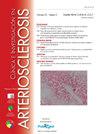血浆 TNF-R1 水平升高可预测冠心病糖尿病患者急性缺血事件的发生。
IF 1.9
Q3 PERIPHERAL VASCULAR DISEASE
引用次数: 0
摘要
研究目的研究2型糖尿病(DM2)和稳定型冠状动脉疾病患者的炎症生物标志物与心血管事件发生之间的关系:方法:共纳入 964 名冠状动脉疾病稳定期患者。测量了血浆中的炎症标志物水平,包括肿瘤坏死因子受体1和2(TNF-R1和TNF-R2)、生长分化因子-15(GDF-15)、可溶性抑制肿瘤生成素2(sST2)和高敏C反应蛋白(hsCRP)。主要终点是急性缺血性事件(任何类型的急性冠状动脉综合征、中风或短暂性缺血性发作)的发生率:共有 232 名糖尿病患者和 732 名非糖尿病患者。冠状动脉疾病和 DM2 患者(232 人,24%)的 TNF-R1、TNF-R2、GDF-15 和 sST2 水平较高:稳定型冠状动脉疾病和 DM2 患者的促炎标志物 TNF-R1、TNF-R2、GDF-15 和 sST2 水平升高。此外,只有糖尿病患者的 TNF-R1 才是急性缺血性事件的独立预测因子。本文章由计算机程序翻译,如有差异,请以英文原文为准。
Los niveles plasmáticos elevados de TNF-R1 predicen el desarrollo de eventos isquémicos agudos en pacientes coronarios con diabetes
Objectives
To examine the relationship between inflammatory biomarkers and the occurrence of cardiovascular events in patients with type 2 diabetes mellitus (DM2) and stable coronary artery disease.
Methods
A total of 964 patients with stable coronary artery disease were included. Plasma levels of inflammatory markers, including tumour necrosis factor receptors 1 and 2 (TNF-R1 and TNF-R2), growth differentiation factor-15 (GDF-15), soluble suppression of tumorigenicity 2 (sST2), and high-sensitivity C-reactive protein (hsCRP) were measured. The primary endpoint was the development of acute ischaemic events (any type of acute coronary syndrome, stroke, or transient ischaemic attack).
Results
There were 232 diabetic patients and 732 non-diabetic patients. Patients with coronary artery disease and DM2 (232, 24%) had higher levels of TNF-R1, TNF-R2, GDF-15, sST2 (P<.001), and hsCRP compared to patients without DM2, indicating a higher inflammatory state. After a median follow-up of 5.39 (2.81-6.92) years, patients with DM2 more frequently developed the primary endpoint (15.9% vs 10.8%; P=.035). Plasma levels of TNF-R1 were independent predictors of the primary endpoint in patients with DM2, along with male gender, triglyceride levels, and the absence of treatment with angiotensin-converting enzyme inhibitors. None of these inflammatory markers predicted the development of this event in non-diabetic patients.
Conclusions
Patients with stable coronary artery disease and DM2 exhibit elevated levels of the proinflammatory markers TNF-R1, TNF-R2, GDF-15, and sST2. Moreover, TNF-R1 is an independent predictor of acute ischaemic events only in diabetic patients.
求助全文
通过发布文献求助,成功后即可免费获取论文全文。
去求助
来源期刊

Clinica e Investigacion en Arteriosclerosis
PERIPHERAL VASCULAR DISEASE-
CiteScore
3.20
自引率
6.20%
发文量
44
审稿时长
40 days
期刊介绍:
La publicación idónea para acceder tanto a los últimos originales de investigación como a formación médica continuada sobre la arteriosclerosis y su etiología, epidemiología, fisiopatología, diagnóstico y tratamiento. Además, es la publicación oficial de la Sociedad Española de Arteriosclerosis.
 求助内容:
求助内容: 应助结果提醒方式:
应助结果提醒方式:


